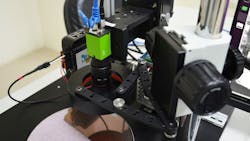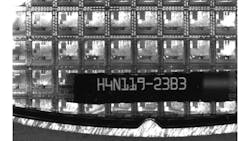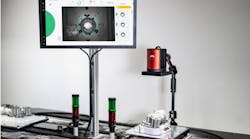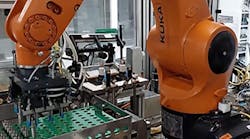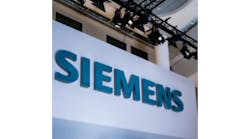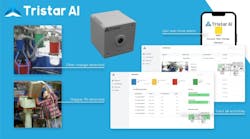A leading semiconductor foundry operation in Taiwan wants to implement a flexible and compact OCR solution to read codes on wafers.
To adopt the type of optical character recognition (OCR) system necessary to accurately track the wafers, foundry executives hired Leader Vision (Taichung City, Taiwan; www.leadervision.com.tw/), a machine vision integrator, to develop a solution, which currently is in the evaluation stage in Leader Vision’s lab.
An official rollout date for the new system hasn’t been determined. Once Leader Vision finishes testing the system in its lab, it will then test the system at the customer’s plant before moving the system into a production mode.
Foundries based in Taiwan, such as Leader Vision’s customer, dominate the manufacturing of semiconductor chips. Indeed, Taiwan accounts for about 65% of the global revenue generated by contracted wafer production, according to The Wall Street Journal.
Taiwan Semiconductor Manufacturing Company (TSMC) is the largest foundry in the world, according to CNBC. Other large foundries in Taiwan include United Microelectronics Corporation and ASE Technology Holding Company Ltd.
In semiconductor foundries, tracking each wafer throughout the production process is important so engineers can pinpoint production issues that need to be corrected or isolate a problematic batch of wafers.
To facilitate tracking, wafers are often marked with alphanumeric codes, which are applied by lasers to defined areas on each side of a wafer. But reading these codes is challenging for numerous reasons, such as the reflective nature of the products’ surface and the tendency of the codes to degrade during manufacturing, making them increasingly difficult to decipher.
Goals of a New System
In the case of Leader Vision’s customer, the goal is to replace the foundry’s existing smart-camera-based wafer reader, which foundry executives have concluded is too inflexible.
The problem is that it is difficult to customize with major modifications, such as for optical character verification (OCV), reading data codes and barcodes, or other inspection tasks, according to Ming Jou Tsai, General Manager at Leader Vision.
Anson Lee, Technical Pre-sales Manager at JAI, developer of the camera used in the new system from Leader Vision, adds that those types of changes would require the vendor to overhaul the software and charge for the time spent, which would be prohibitively expensive for the foundry.
Flexibility in the new system is important because foundry executives want to make changes as necessary to meet the specific inspection requirements of its customers in the high-tech industry.
Equally important, a flexible system would allow the foundry to make changes to accommodate modifications in the wafers themselves. It is common for the design of the wafers to change every year, as the semiconductor companies strive to keep pace with changes in their customers’ products, Lee says. Mobile phones, for example, are prominent examples of such high-tech products that evolve continually.
In addition to flexibility in its new system, the foundry also wants an OCR solution with a small footprint because semiconductor manufacturing processes are conducted in a clean-room environment where space is limited. Easy integration with its existing manufacturing processes and systems also is important to the company, Tsai says. The software code will be turned over to the foundry, and the system is designed so foundry engineers can modify or update the system as needed in the future.
Design of the New OCR System
To meet the need for flexibility and compactness, Leader Vision opted to develop an embedded OCR system using a NVIDIA (Santa Clara, CA, USA; www.nvidia.com/en-us/) Jetson Nano core processor and standard PC monitor. “In the embedded system, we can integrate all of the required interfaces and functionalities in a smaller mechanism” than would be the case with a PLC-based system, Tsai explains.
Leader Vision developed the OCR application, using QT C++, which is a cross-platform development environment that works for desktop, embedded, and mobile applications. Tsai says the decision to use this framework sped up system design because developers did not have to compile code for a X86 CPU using C++ and then port the code over to the embedded processor to execute the program. “Once the source code is written using QT C++, it can be deployed immediately,” Tsai explains.
The software Leader Vision developed using the framework and installed on the NVIDIA platform includes all communication between hardware components, such as the camera and PC monitor. The system uses twisted-pair Ethernet cables and GigE vision interface.
To overcome the challenges involved in recognizing codes on wafers, Leader Vision incorporated deep learning algorithms to perform the character recognition. It opted to use HALCON Deep OCR software from MVTec (Munich, Germany; www.mvtec.com). As Tsai explains, “Using HALCON Deep OCR can save steps in character location and segmentation, and further save time in programming. The user can also benefit from improved usability and a more stable recognition rate.”
Leader Vision also used HALCON for light-source control functionality. The integrator did not face illumination challenges in this project, Tsai says.
Another advantage of the HALCON software is that it can be updated with new algorithms to accommodate changes in the size or type of code to be read on the wafers, Lee notes.
In addition to the NVIDIA platform and monitor, the system includes a GOX-2402-PGE Bayer color area-scan camera from JAI (San Jose, CA, USA; https://jai.com/). The camera contains an IMX392 global shutter CMOS sensor from Sony (Tokyo, Japan; www.sony.com) and has been fitted with a 25 mm CCTV C-mount lens. Illumination is provided by a red ring light.
Leader Vision chose the camera because of its features. “The resolution of the GOX-2402-PGE was ideal for our system. It delivers 2.3-MPixel Bayer color output at up to 50 fps over a GigE Vision interface. Another strong point is the camera’s speed—it can recognize codes at an average speed of 20 to 30 codes per second. We also considered the camera’s high stability and industrial-grade reliability before zeroing in on it,” Tsai says.
Lee adds that the OCR system Leader Vision built is designed to allow the foundry to swap out the camera in the future as its needs change. “They can basically reuse their entire system,” he says.
The OCR system will be installed at strategic locations throughout the factory to read the codes as wafers move from one step in the fabrication process to the next.
Leader Vision’s system is flexible enough for the integrator to modify it and then sell it to other foundries or even manufacturers in other industries, Lee says. “You can imagine swapping the wafer out and putting in another object with an identification code. Basically what (the system) does is track code, so whatever the code is, the system should be able to track it,” Lee says.
